Your project manager has requested that you run management reviews in her absence. Which two of the following might you be expected to do at these reviews?
a. Check for defects in requirements documents.
b. Check the process to see if it passes the assessment.
c. Check the consistency of the project plan.
d. Check compliance by conducting evidential interviews
e. Check adequacy of management procedures.
f. Check contractual compliance for a software product Select one correct answer from the options below:
Which of the following is a key characteristic of a management review? [1]
You have recently implemented a new defect management process which now includes a defect triage committee whose job is to review all new defects. The process is shown in the following diagram:
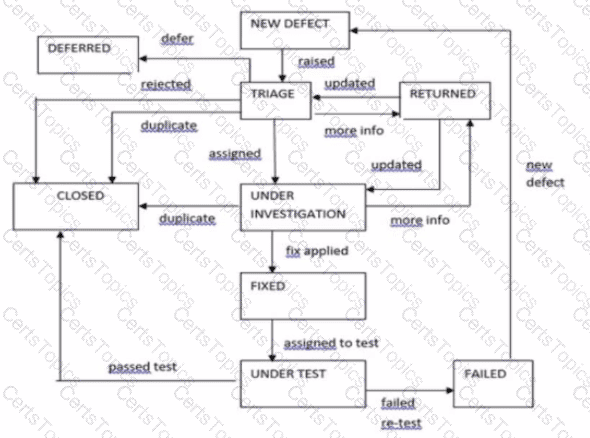
b. The total number of defects rejected as not a problem following investigation by the product author
c. The number of defects returned to the defect author, expressed as a percentage of all defects raised
d. The total number of defects that failed re-test more than once
e. The total number of defects closed by the defect triage committee
SELECT ONE OPTION
In relation to cost of quality, which of the following would be classified as a cost of detection? SELECT ONE OPTION
Which of statement about defect management is TRUE?
You are a Test Manager at a company that develops mobile phone applications. Based on historical data in your company, you have calculated the following average metrics for system testing:
• for each 100 LOC (Lines Of Code). 4 test cases are executed
• each test case takes on average 15 minutes to execute and check
• for each 1000 LOC, 5 defects are found
You have used this information to create an estimate for the system testing of a new mobile phone application being developed to submit gas and electricity readings.
The application delivered for system testing has 50.000 lines of code. At the end of system testing, 250 defects are discovered.
Assume that:
• the system test of the new mobile phone application will require the same amount of effort as previous applications
• defect density = number of defects/1000 LOC
• no new tools or processes have been introduced to the test team
Based only on the given information, which one of the following statements is true about this new mobile phone application?
SELECT ONE OPTION
A test team is working long hours to achieve a deadline for release of a new product which has had problems throughout development and is well behind schedule. Which of the following is most likely to have a MOTIVATING effect on the testers in the team?
SELECT ONE OPTION
What is the purpose of process improvement assessment models? [1]
You are the Test Manager of a four-person test team working for a small distribution company with a single warehouse. Your team has been working with a third party development team on a new
inventory management system. The company expects this system to generate approximately one million dollars per annum in profits for the company. Early in the project, various risks were
identified, and steps taken to mitigate those risks.
For example, you sent your test team for training on the new system, and upgraded the test environment. There are still some lingering risks that have not been addressed, but they have been
determined to have a low chance of occurring, with minimal impact if they do occur.
What would be the best option to mitigate these remaining risks? [3]
You are the Test Manager on a new project. The schedule is aggressive and will require the team to work at peak efficiency. The requirements are not well defined yet, but it is clear that the
project will be using new technologies. To help the developers meet the development schedule, an offshore group will be added to the development team.
At this time there is not enough budget to add more testing resources. The project stakeholders are very concerned about the quality of delivered product and will be watching the project closely,
particularly during the testing cycles. The exit criteria from the system test level require no open high priority/severity defects, 100% pass rate for all test cases covering risks that are classified as
"high" or "very high", 90% pass rate for all "medium" risks and 50% pass rate for all "low" and "very low" risks.
Given this information, which lifecycle model should you recommend? [3]
Which one of the following is NOT a determining factor when considering the optimal time to conduct a document review? SELECT ONE OPTION
You are a Test Manager and have started a program of test process improvement. You are following the IDEAL model and have completed the first three phases, now you are ready to go further. Which TWO of the following activities will enable you to complete the remaining phases of the IDEAL model?
Refer to SCENARIO 2 It has been agreed that the following test planning documents will be produced;
• A single overarching document outlining the general testing methodology for the whole programme of work
• A subordinate test plan for each of the three projects
• A separate test plan for performance testing within each project
Which one of the following options BEST describes the type of test management document that will meet the programme requirements?
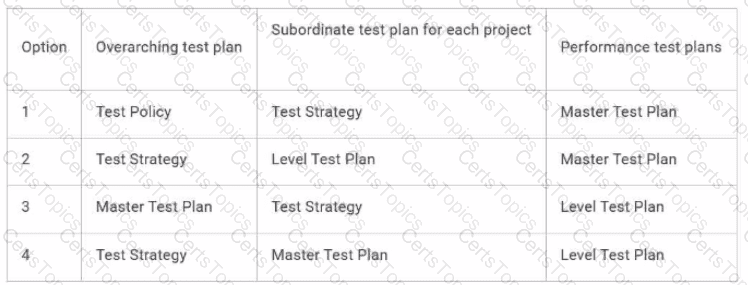
Mary is an external IT auditor. She is conducting a review of the system-level testing done by Greg's functional testing team.
Which of the following items from Mary's assessment summary should concern Greg the most? [2]
The test team is using a distributed model for testing.
What is the primary factor you should consider with this model? [1]
Refer to SCENARIO 2 - You have been tasked with recruiting testers for Project 3 to help design and run regression tests, you have been provided with a skills matrix for four prospective candidates. The matrix shows the skill level (High or Low) for each candidate:
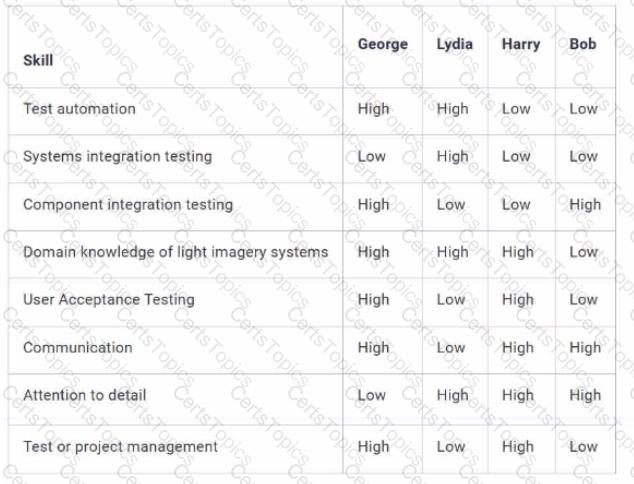
Which candidate would be the MOST suitable for a test analyst role on Project 3?
SELECT ONE OPTION
Which statement about defect management in Agile software development is TRUE?
You are Test Manager on a major project that is of strategic importance to your company. Your team has access to a suite of testing tools that provide support across the development life cycle and thissuite of tools has been in place for the last two projects. You are concerned that the suite does not have an integrated defect management tool and have negotiated a small budget to find and implement such a tool. Your first choice is an open source tool that has been available for just over a year and appears to be popular with its users, who have found it easy to learn. The main disadvantage of the tool would be that current manual defect management processes would need to be modified to embrace use of the tool.
Which of the following would be the MAIN risk to consider in deciding whether or not to acquire the defect management tool? SELECT ONE OPTION
Refer to SCENARIO 1
Week 4 of test execution has been completed and the following test report has been produced
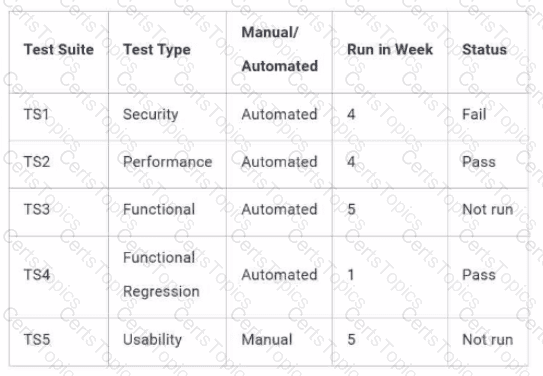
Review this report against the organisational Test Strategy, what is the status of the Test Strategy objectives? SELECT ONE OPTION
You are documenting a test methodology for your organisation and have specified that the following activities must be adopted for all future projects: 1. The design, implementation and execution of tests to mitigate the quality risks
2 Extensive use of checklists to test web page navigation
3 Exploratory test sessions to be integrated into the test schedule Consider the following test strategies:
a. Analytical test strategy
b Methodical test strategy
c. Process or standard compliant test strategy
d Reactive test strategy
e. Regression-averse test strategy
Which three of these strategies is MOST appropriate for this organisation?
SoftTech provides a core banking product to retail banks to enable their customers to process payments via the Internet and telephone banking and. as SoftTech's Test Manager, you are responsible for system testing and system integration testing of all SoftTech's products.
Your current project is to integrate SoftTech's core banking product with an existing bank's systems, which are maintained by experienced developers but poorly
documented.
A specification for the 10 interfaces to the bank's existing systems has been produced by SoftTech's development team. There is an estimating matrix for system integration testing that allows 2 man days per interface for preparation, plus 2 man days per interface for test execution. The exit criteria for the completion of system integration testing has been agreed as:
1. No open Severity 1 defects
2 No more than 10 open severity 2 and/or 3 defects
3. All interfaces tested
4. Cost estimate must not be exceeded
System integration test execution is scheduled to last 5 weeks, with week 5 reserved for regression and bug fixing only. At the end of week 3 the following test report has been produced (figures on a week by week basis, not cumulative):

B. Open severity 2 and 3 defects
c. Interface testing progress
d. Development resource for debugging
e. Available budget
SELECT ONE OPTION
Your company is installing a third-party enterprise-wide business software package. This is the first time the company has done anything like this.
Which technique would be the best one to use to estimate the testing effort? [3]
An old stock control system is being decommissioned and replaced with a new system that has been running successfully in the live environment for the last few months. The stakeholders would like to -
• retain historical information held in the database to comply with their data retention policy (which requires order information to be retained for 7 years)
• query the historical information by running pre-written SQL queries.
• all commands must be invoked by keyboard as one of the end users is unable to use a mouse
The pre-written SQL queries will be designed, developed and tested by the developers who are decommissioning the system and writing the data migration routine.
As the system to be decommissioned is integrated to other systems that will remain operational, the stakeholders have requested that testing incorporates all systems that are part of the stock control suite.
The stakeholders and project manager have identified the following risks, in priority order -
• 1st - Data has not been successfully migrated to an archived data store, resulting in the inability to query past stock levels and re-order details.
• 2nd - Historical data for the last 7 years is unavailable, resulting in the failure to meet the data retention policy.
• 3rd - Failure of existing systems within the stock control suite, adversely affecting the operational running of the business
The risks are to form the basis of the test objectives. Which three of the following test activities, work products and/or resources achieves the test objectives?
a. Use of the live database to test the data migration does not corrupt or lose data
b. A test plan detailing the test approach for ST. SIT & OT test levels
c. Accessibility testing of the pre-defined SQL queries
d. Security and Penetration testing of the archived database
e Performance testing of the data migration exercise to ensure it completes in the time specified by the stakeholders
f. Functional testing of the pre-defined SQL queries
g. Regression testing of the end to end process for maintaining specified stock levels.
You are writing the project test plan and are analysing the following risks in the project risk register:
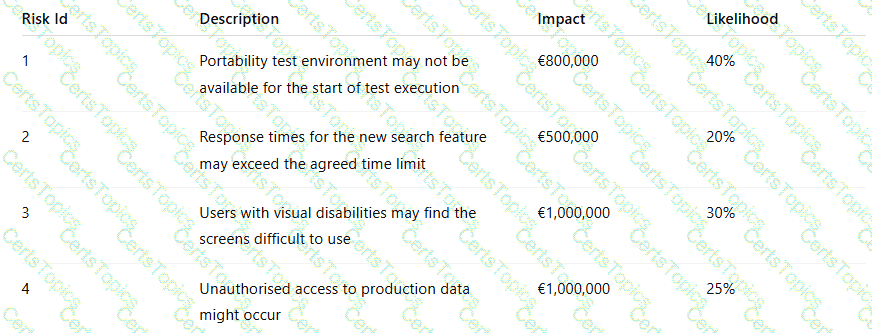
Which would be the MOST appropriate test activities to mitigate the product risks?
You have been asked to implement formal reviews at your company. From the list below, what are the correct characteristics of a formal review?
a. Entry and exit criteria have been defined.
b. Checklists created to be used by all reviewers.
c. Consistency with current project plan is checked.
d. Metrics on effectiveness will be gathered.
e. The review will be moderated by a lead auditor.
The previous release of an in-house invoicing application was live for 6 months before beingreplaced by a later release.
• Before it went live, €1,500 had been spent on defect prevention and a further €4,500 had been spent on writing and running tests; these tests found 80 defects and the average cost of dealing with these was €50 each.
• By the time that it was replaced, defect reports from live running showed that pre-release testing had found only 80% of the defects that were present; the average cost of dealing with the defects that went live was 12 times that of the internal failures.
Which statement is TRUE?
Your organisation has decided to move from using the V-model software development lifecycle to Agile Scrum. Due to inexperience in Agile methodologies and to mitigate risk, the next project will use a hybrid model, beginning with a traditional requirement definition phase and transitioning to an Agile Scrum approach for development and testing.
Which would be an appropriate test management task to perform FIRST for this next project?
You are the manager of a test team. You inherited most of these people from a previous manager who promoted technical skills, particularly
programming skills. As a result, your people are very strong in test automation skills, white box testing and complex test design
techniques. You have just been told that you can hire five new people. You want the new people to complement the existing skill sets and
you want to be sure the team will have a strong mutual respect.
Given the following options, who should you hire? [3]
Your testing team has just received the test conditions for a new project. You are conducting Test Design activities for this project. Your team feels that it would be beneficial to create high-level test cases.
What should they do concurrently with creating these test cases? [2]
You are Test Manager of a project delivering a workflow system for complex business processes It has been decided a tool is required to increase the efficiency of test execution. What would be a valid issue to consider when deciding whether to build a custom made tool?
SELECT ONE OPTION
You are the Test Manager on a project to replace an old sales and merchandising system with one that will be based on modern platforms It will be developed using an Agile lifecycle.
The main requirements for the system are:
Loading sales data, sent electronically from the stores each evening, into a central database.
Producing sales reports for the merchandisers, whose job is to manage stock levels in stores.
Producing forecast reports, used to predict demand for each product, based on a combination of sales history and forecasting parameters. The parameters will be entered by the merchandisers into a browser based front end and the reports will be produced overnight.Requirements 1 and 2 are satisfied by the existing system and will be rewritten with no significant changes. Requirement 3 is new.The Data Centre Manager is concerned about the performance of overnight batch processing and the Sales and Merchandising Manager is concerned about usability. Both managers have indicated that they are keen to allocate resources to acceptance testing.You have already determined that component and component integration testing will be done by developers before any other testing.
Which option contains TWO items that would complete your test approach in respect of test levels?
When scheduling performance testing, which of the following approaches would be most advisable? [1]
Which one of the following will allow phase containment to be assessed within a testing project? SELECT ONE OPTION
You are reviewing the project's traceability matrix after the first cycle of testing. You have discovered that new requirements have been introduced and others have
changed.
What should you do? [2]
You tend to be conservative in your project estimations because you know how many things can go wrong and extend the schedule. You manager is not happy with your estimates and thinks you are being too negative with your numbers and not trying hard enough Which estimation method should you use to provide your manager with a positive' number while still also providing the number you think is more realistic?
You feel that your team has become lazy when applying good software testing techniques You have given each of them a challenge to take a different business rule and build a full decision tableand then collapse that table You will then assess the results For this assessment, what competencies are you validating?
You have assembled the following cost of quality numbers 1 000 defects were found prior to release and 100 were found after.
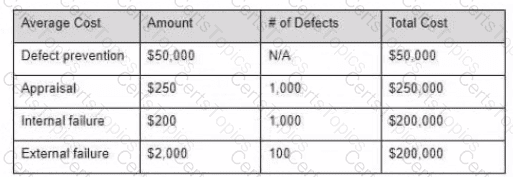
Given this information what should you conclude?
You are working on a project where the business part of the organization works traditionally with defined requirements, but the development team follows an Agile model Neither team plans to change their approach What is the proper name for this type of project approach''
Which of the following best describes the appraisal costs in the cost of quality'
At what testing level do the test management activities Include coordinating with end users7
Which of the following Is the common set of information to be produced in a test estimate''
Which of the following is required to apply an experience-based testing approach''
In an Agile project, when Is it acceptable lo not write a formal defect report when a defect is found''
You have decided to help your team improve their skills. One of their assignments is to mentor a junior member of the team Which competency should you expect the mentor to develop during this exercise?
Which of the Mowing Is commonly used by a test manager to identity risks'
There is a debate in your organization about who can close a defect report The developers think they should be able to reject and close defects without any further steps The testers are not happy with this approach as they are afraid the rejections may go undetected and the developers may close something without understanding the real problem
How can this problem be rectified7
You have been looking at the actual vs expected defects in one high risk area of the software The actual is much higher than the expected value What should you do?
In what environment are you most likely to see multiple defect management systems used in one project?
You have been asked to estimate the testing effort for an upgrade to a legacy product Your team did the testing on the last upgrade, and you have ascertained that this upgrade is about 10% bigger than the last one Given this information which estimation technique should you use to come up with the test effort number?
You are working on a project that is having problems with regressions. With each release of software given to the test team. 50% of the defects found are actually regressions. To combat this you have decided to implement test automation. You have given your automation team the following goal
'Implement lest automation to automate 90% of the manual regression tests before the product release date.’’
Which of the following is likely an issue with this goal being defined as "SMART?
Your defect opened trend is converging to the closed trend but there is still a gap. What does that gap represent?
Which of the following defect statistics will provide input to be used for improvement in the defect reporting process?
Which of the Mowing should be used to understand the context of testing within an organization?
Which of the following Is considered a heavyweight risk-based testing technique'
You are working with a development team who have a CI/CD pipeline implemented. They want to integrate your team's existing test automation into the pipeline to augment their unit tests so they will have continuous testing. They have already determined that this is technically possible with the tool you are using but with require some changes to the test automation framework to integrate the results reporting
What will your team need to make this happen?
You are managing the testing for a bank card project. The testing was scheduled to take 10 weeks but by the time the software was developed only six weeks were available for testing Knowing there were a lot of risks with the software your team started testing activities early by overseeing code reviews, defining acceptance criteria by working with the users and by doing all lest creation prior to the code arriving
You are now three days away from the go-live date Your testing has mitigated all the high and medium risk items leaving only the low-risk elements unmitigated by testing You estimate it will take two weeks to manually test the low-risk elements At this point what should you do?
Your manager has decided that your team of manual testers should all become test automation engineers Your team is much stronger in analysis than In technical testing so you are concerned about their ability to adapt. What tool capabilities could help with this transition?
What is the purpose of the defect management committee?
Your team has been assigned to test a loyalty card program for a supermarket chain. Because this is a highly competitive market significant investment has been made to determine the shortcomings of the products offered by competitors While the feature sets are mostly the same, there is a wide variance In usability and performance and the users perceptions of these quality characteristics
Given only this information what test approach would be most appropriate?
It the lest manager must repeatedly step in to resolve conflicts within the team what phase is the team in and what competencies are required from the test manager?
When Is the metric for the percentage of requirements coverage defined?
If you are monitoring code coverage during testing to determine what areas still need testing what type of testing is likely occurring?
What occurs In the retrospective closing?
Your team has been given the following test objective Ensure that the users are happier with this version than they were with the last version?
What is wrong with the way this is defined?
Your organization has decided to augment your testing team with an offshore team. The offshore team members are experienced testers who are experts in the domain of the system under test Your team is worried about the offshore team taking their jobs and they are resistant to the change You need to pick three of your team members to be the ambassadors for the new team
Which competences will be most important for your ambassadors to possess?
You are a new lest manager in an organization You have been asked to assess the defect process to determine if there are any efficiency improvements that could be made that would reduce the cost of quality You have started digging through the defect Information What information would be most helpful for this investigation?
Which test process improvement model consists of five maturity levels?
Which of the following is the proper order for the stages of a tool lifecycle?